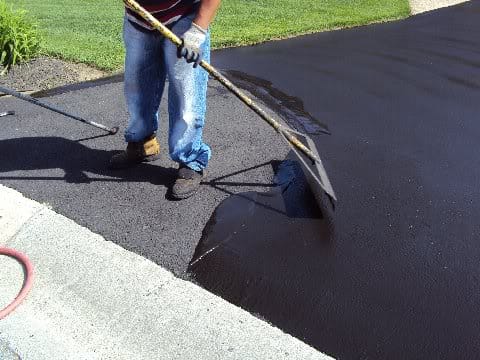Discover the Power of Industrial Parking Area Paving and Asphalt Sealing
Discover the Power of Industrial Parking Area Paving and Asphalt Sealing
Blog Article
Hot Mix Asphalt: A Sustainable Solution for Sidewalk
Warm Mix Asphalt (HMA) has actually emerged as a leading lasting option for pavement remedies, supplying a myriad of environmental benefits and ingenious innovations. Its capability to minimize and reuse products power consumption provides an engaging instance for its adoption in road building and construction jobs. The long-lasting efficiency and toughness of HMA make it a recommended option for infrastructure growth. As the demand for environment-friendly building methods expands, checking out the subtleties of HMA's sustainability can offer important insights into the future of sidewalk solutions.
Environmental Benefits of Hot Mix Asphalt

Furthermore, Warm Mix Asphalt helps to alleviate urban warmth island effects. Its dark shade absorbs sunshine, reducing the quantity of heat reflected back right into the environment compared to lighter-colored sidewalks. This can lower ambient temperatures in urban locations, lowering the need for cooling and ultimately minimizing energy usage.
Additionally, Hot Mix Asphalt contributes to boosted stormwater monitoring. Its porous nature allows water to recharge and infiltrate the pavement groundwater materials, reducing runoff and the danger of flooding. These ecological advantages make Hot Mix Asphalt a lasting option for paving freeways and roadways.
Energy Performance in HMA Manufacturing
Is energy effectiveness a vital aspect in the production of Warm Mix Asphalt (HMA)? Power plays a substantial duty in the production of HMA, influencing both cost and environmental sustainability. One crucial element of energy performance in HMA manufacturing is the usage of warm mix asphalt (WMA) technologies.
Furthermore, advancements in plant modern technologies have led to even more energy-efficient HMA production procedures. Modern plants are created with features like recycled asphalt sidewalk (RAP) processing capacities, effective burner systems, and boosted insulation, all adding to power cost savings. By maximizing energy use in HMA production, the industry can minimize its carbon footprint while keeping premium pavement products. Power effectiveness is, therefore, a crucial consideration in guaranteeing the sustainability of Hot Mix Asphalt manufacturing.
Recyclability of Hot Mix Asphalt
The recyclability of Warm Mix Asphalt (HMA) is a critical facet of its sustainability and long-lasting ecological impact. HMA is among one of the most recycled products in the United States, with over 100 million lots of redeemed asphalt pavement (RAP) being recycled annually in new sidewalk construction. Recycling HMA provides several environmental advantages, such as decreasing the requirement for virgin products, decreasing power consumption during production, and lowering the quantity of waste sent to landfills.
The procedure of reusing Read More Here HMA entails crushing the existing sidewalk, squashing it right into smaller sized pieces, and mixing it with new aggregate and asphalt binder to create a recycled mix. This recycled mix can usually perform as well as or perhaps better than traditional HMA, while needing fewer resources and creating lower greenhouse gas discharges. By integrating RAP into new pavement projects, road agencies can conserve natural deposits, lower prices, and decrease the ecological impact of road building and construction and upkeep activities. Generally, the recyclability of HMA plays a substantial duty in advertising sustainable practices within the pavement industry.

Long-Term Efficiency of HMA
Asphalt sidewalks demonstrate sturdiness and resilience over an extensive period, showing the long-term efficiency of Warm Mix Asphalt (HMA) Furthermore, innovations in HMA innovation, such as the usage of polymer-modified binders and warm mix asphalt, have better enhanced the longevity and longevity of HMA sidewalks. By focusing on high quality building and upkeep techniques, HMA proceeds to confirm itself as a lasting and economical remedy for durable sidewalk framework.

HMA: Sturdiness and Sustainability
Showing both toughness and sustainability, Hot Mix Asphalt (HMA) has come to be a cornerstone in the building and construction of resilient pavement facilities - angled parking. HMA's durability comes from its ability to hold up against heavy lots, severe climate conditions, and high website traffic volumes, making it a trusted option for highways, highways, and airport terminal runways. The composition of HMA, which commonly includes accumulations, binder, and filler, plays an essential duty in enhancing its durability and resistance to tear and wear
Additionally, HMA's sustainability hinges on its recyclability and energy-efficient production procedure. The capacity to reuse recovered asphalt sidewalk (RAP) in brand-new HMA mixtures decreases the need for virgin products and minimizes the environmental influence of pavement building and upkeep. Additionally, the energy effectiveness of generating HMA lies in its reduced mixing temperatures contrasted to various other pavement materials, causing reduced energy usage and greenhouse gas exhausts.
Conclusion
In final thought, warm mix asphalt (HMA) offers a sustainable remedy for pavement with its more environmentally friendly qualities. HMA's recyclability, power performance in production, and long-lasting durability make it a green click now choice for road building. By saving natural deposits, decreasing waste, and reducing greenhouse gas discharges, HMA plays an essential duty in advertising sustainability in infrastructure development. Its ability to mitigate city warmth island impacts better underscores its relevance in developing environmentally mindful and resilient pavement systems.
HMA is one of the most recycled products in the United States, with over 100 million heaps of recovered asphalt pavement (RAP) being reused each year in brand-new pavement building and construction.The procedure of recycling HMA involves crushing the existing pavement, squashing it right into smaller items, and blending it with brand-new accumulation and asphalt binder to produce a recycled mix.Asphalt pavements demonstrate resilience and strength over a prolonged period, reflecting the lasting efficiency of Hot Mix Asphalt (HMA) Additionally, innovations in HMA innovation, such as the use of polymer-modified binders and cozy mix asphalt, have further enhanced the durability and long life of HMA pavements. The capacity to reuse redeemed asphalt pavement (RAP) in brand-new HMA mixes lowers the demand for virgin products and lessens the ecological effect of sidewalk building and upkeep.
Report this page